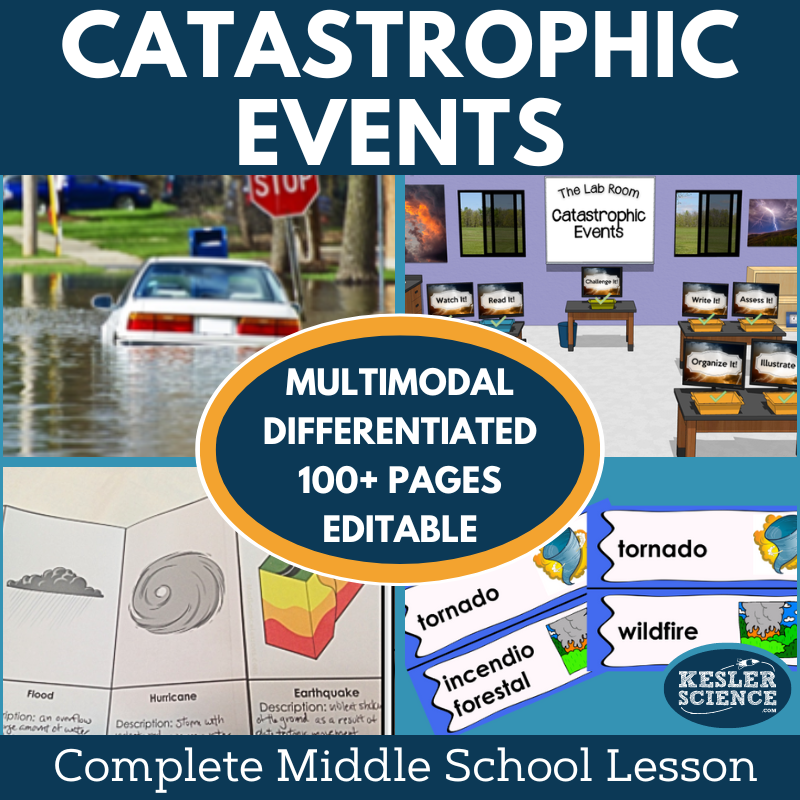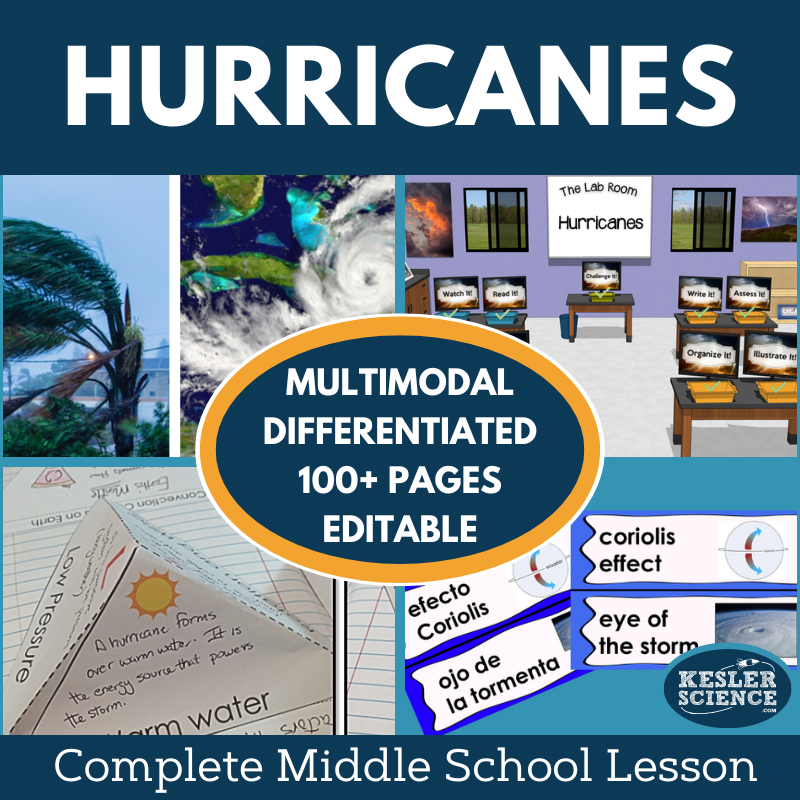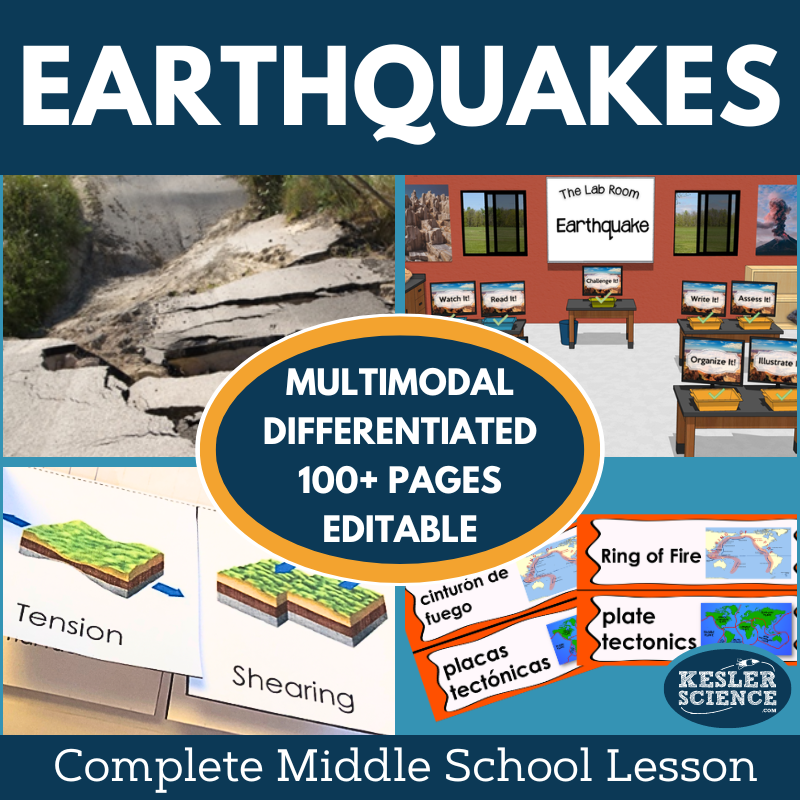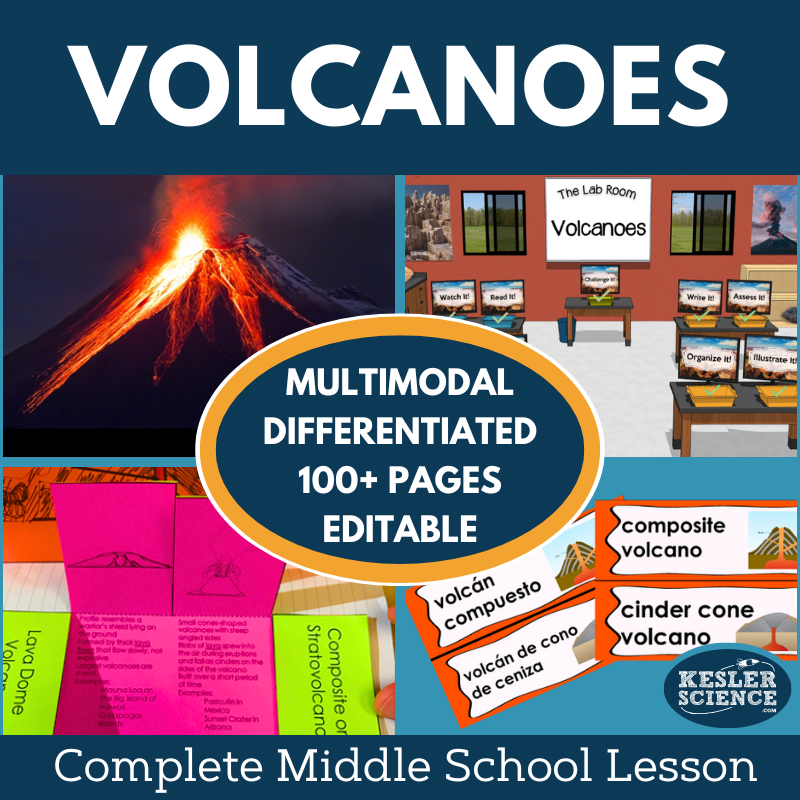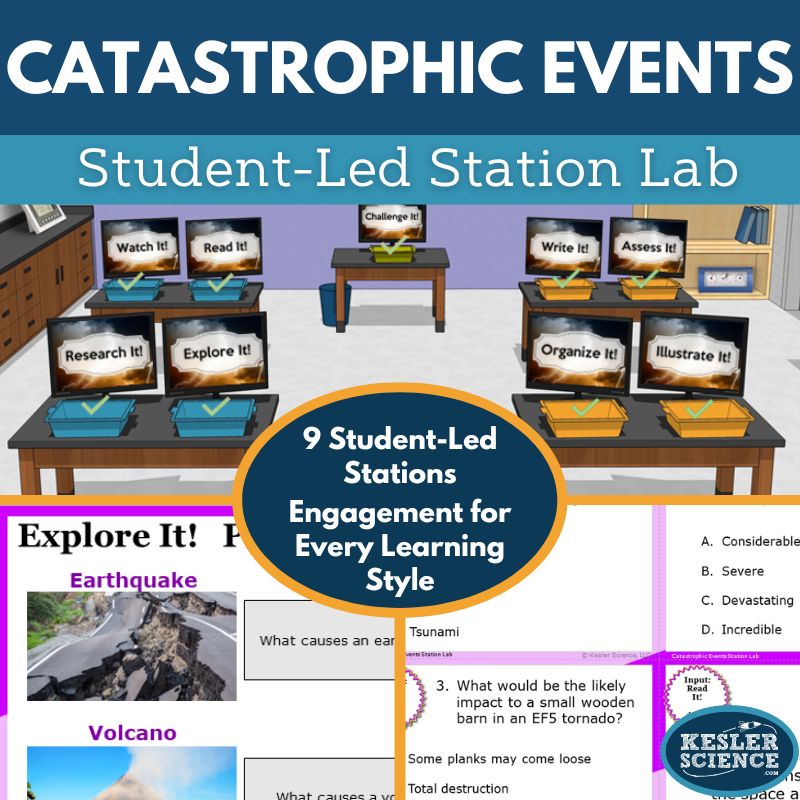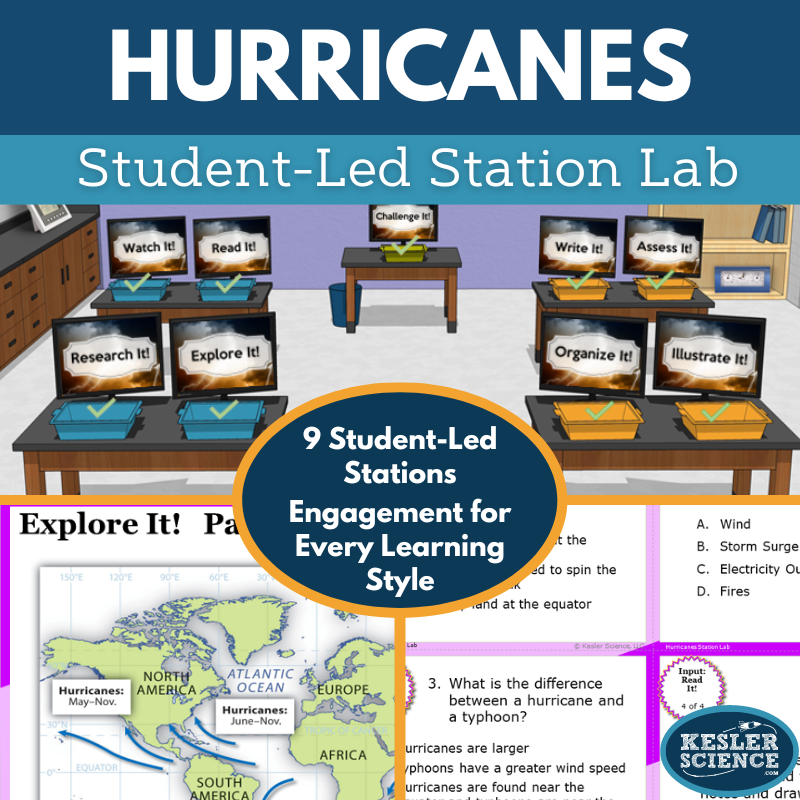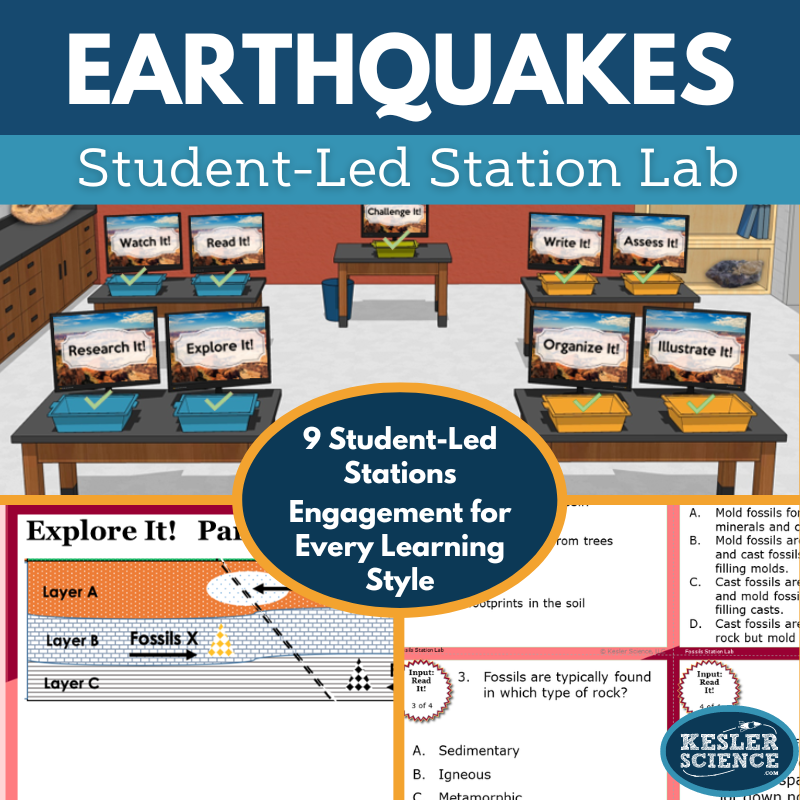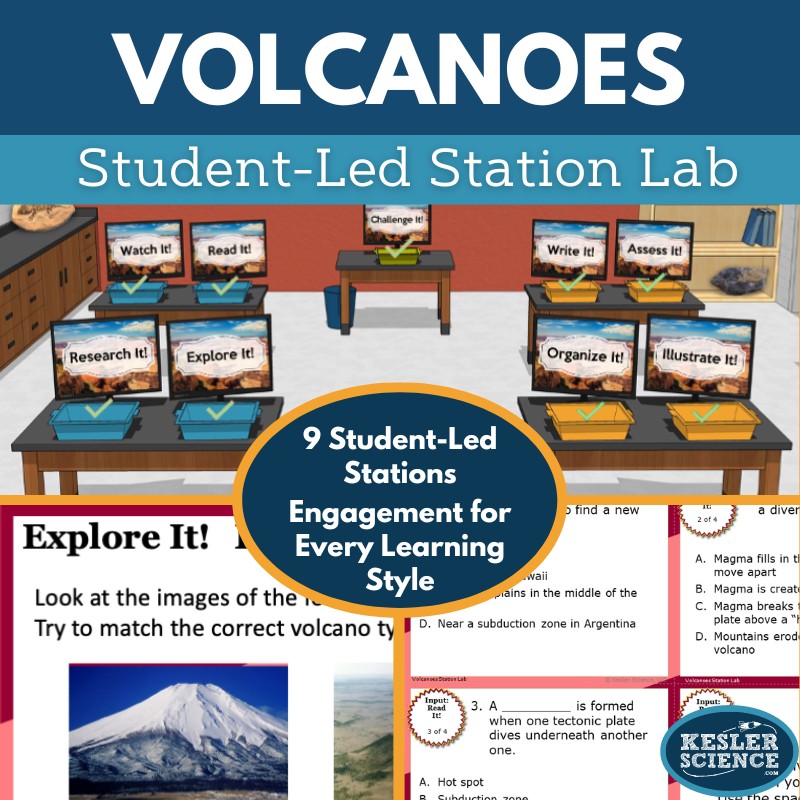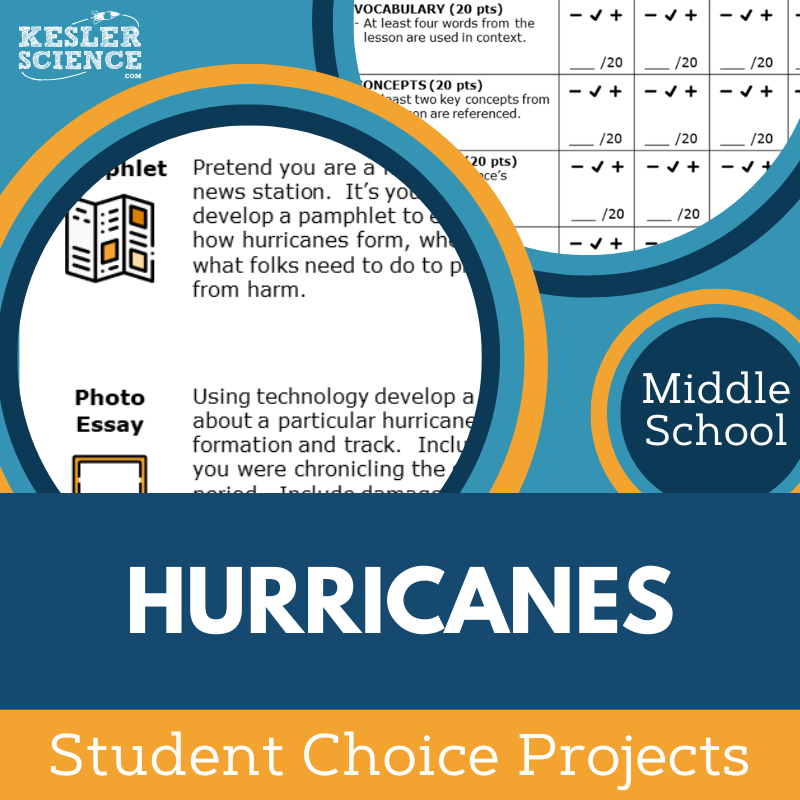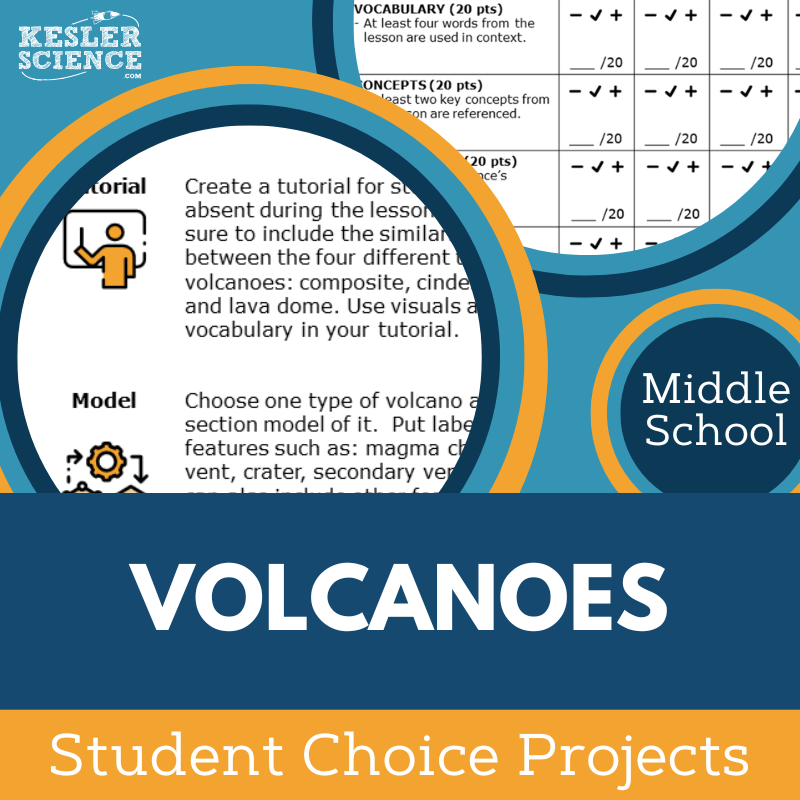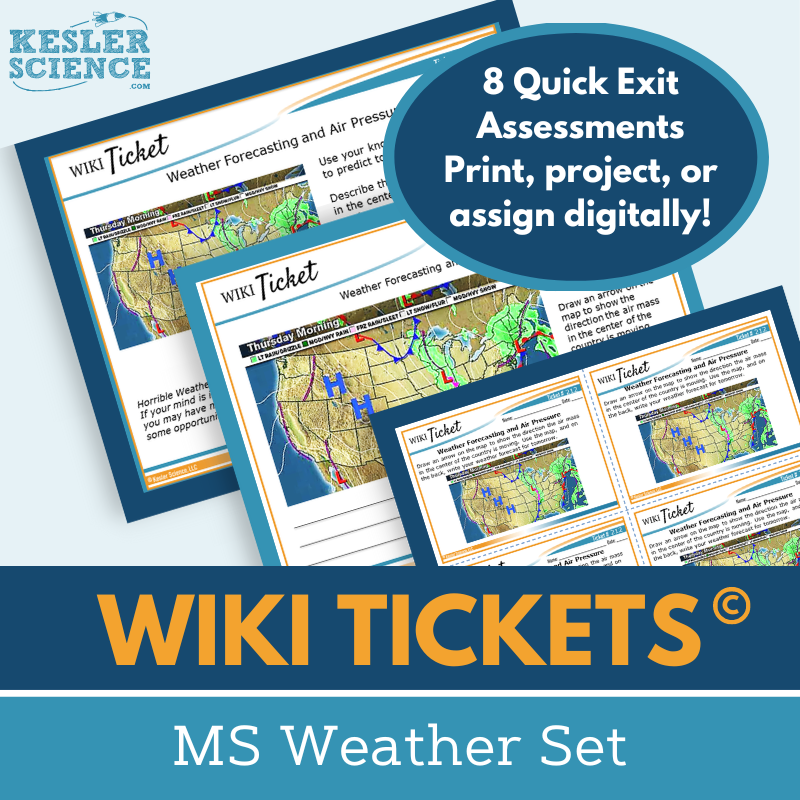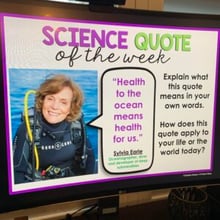Forecast Catastrophic Events Activities for Middle School Science
The Kesler Science 5E Lessons provide comprehensive, student-led units that explore catastrophic events, hurricanes, earthquakes, and volcanoes through the 5E Model: Engagement, Exploration, Explanation, Elaboration, and Evaluation. The resources below will give students a comprehensive understanding of forecasting catastrophic events. All of the following materials are also included in the Kesler Science Membership.
The Kesler Science Catastrophic Events 5E Lesson is a comprehensive middle school unit designed to explore how catastrophic events impact ecosystems. Based on the research-backed 5E Model (Engagement, Exploration, Explanation, Elaboration, Evaluation), it provides differentiated, multimodal activities suited for varied learning styles. The lesson includes editable PowerPoints, interactive notebook templates (digital and printable), and resources available in both English and Spanish.
Students engage through vocabulary and classroom discussions, explore through differentiated station labs (hands-on activities, readings, multimedia, and research), and explain concepts using editable presentations and structured notes. Student-choice projects offer elaboration opportunities, while STAAR-aligned assessments support evaluation. This unit adapts easily for virtual or classroom use, ensuring maximum flexibility with minimal prep time.
The Kesler Science Catastrophic Events 5E Lesson is a comprehensive middle school unit designed to explore how catastrophic events impact ecosystems. Based on the research-backed 5E Model (Engagement, Exploration, Explanation, Elaboration, Evaluation), it provides differentiated, multimodal activities suited for varied learning styles. The lesson includes editable PowerPoints, interactive notebook templates (digital and printable), and resources available in both English and Spanish.
Students engage through vocabulary and classroom discussions, explore through differentiated station labs (hands-on activities, readings, multimedia, and research), and explain concepts using editable presentations and structured notes. Student-choice projects offer elaboration opportunities, while STAAR-aligned assessments support evaluation. This unit adapts easily for virtual or classroom use, ensuring maximum flexibility with minimal prep time.
The Kesler Science Hurricanes 5E Lesson provides a comprehensive middle school unit exploring how hurricanes form, are measured, and tracked. Built around the 5E instructional model (Engagement, Exploration, Explanation, Elaboration, Evaluation), this lesson includes editable presentations, interactive notebooks in English and Spanish, differentiated worksheets, and student-choice projects to promote active, multimodal learning.
Students engage with essential questions about hurricanes and oceanic influences on weather systems through class discussions and vocabulary activities. In the Exploration phase, a differentiated station lab includes interactive tasks such as hands-on demonstrations, reading passages, research activities, and multimedia resources, allowing students multiple ways to grasp complex concepts. Explanation resources include editable PowerPoints and note-taking guides. The lesson extends learning through student-choice projects and provides evaluation materials aligned with STAAR 2.0 assessments. Suitable for both traditional and virtual classrooms, this lesson supports diverse learning styles with minimal prep needed.
The Kesler Science Hurricanes 5E Lesson provides a comprehensive middle school unit exploring how hurricanes form, are measured, and tracked. Built around the 5E instructional model (Engagement, Exploration, Explanation, Elaboration, Evaluation), this lesson includes editable presentations, interactive notebooks in English and Spanish, differentiated worksheets, and student-choice projects to promote active, multimodal learning.
Students engage with essential questions about hurricanes and oceanic influences on weather systems through class discussions and vocabulary activities. In the Exploration phase, a differentiated station lab includes interactive tasks such as hands-on demonstrations, reading passages, research activities, and multimedia resources, allowing students multiple ways to grasp complex concepts. Explanation resources include editable PowerPoints and note-taking guides. The lesson extends learning through student-choice projects and provides evaluation materials aligned with STAAR 2.0 assessments. Suitable for both traditional and virtual classrooms, this lesson supports diverse learning styles with minimal prep needed.
The Kesler Science Earthquakes 5E Lesson is a comprehensive, student-led unit designed for middle school earth science. It includes editable presentations, worksheets, assessments, and choice projects, all requiring minimal prep. The lesson aligns with NGSS and the 2021 TEKS standards and follows the 5E Model: Engagement, Exploration, Explanation, Elaboration, and Evaluation.
Students explore key concepts such as plate boundaries, seismic waves, fault stresses, epicenter determination, tsunami formation, earthquake measurement, and preparedness. The unit incorporates multimodal learning with differentiated materials, printable and digital formats, and Spanish translations of key resources.
The Exploration phase features a student-led station lab with nine stations offering hands-on activities, reading passages, research tasks, videos, and interactive assessments. Explanation includes editable PowerPoints, interactive notebook templates, and note-taking guides. Elaboration provides student-choice projects, while Evaluation includes STAAR 2.0-aligned assessments and review activities.
This flexible resource is designed for both classroom and virtual learning, ensuring accessibility for diverse learners.
The Kesler Science Earthquakes 5E Lesson is a comprehensive, student-led unit designed for middle school earth science. It includes editable presentations, worksheets, assessments, and choice projects, all requiring minimal prep. The lesson aligns with NGSS and the 2021 TEKS standards and follows the 5E Model: Engagement, Exploration, Explanation, Elaboration, and Evaluation.
Students explore key concepts such as plate boundaries, seismic waves, fault stresses, epicenter determination, tsunami formation, earthquake measurement, and preparedness. The unit incorporates multimodal learning with differentiated materials, printable and digital formats, and Spanish translations of key resources.
The Exploration phase features a student-led station lab with nine stations offering hands-on activities, reading passages, research tasks, videos, and interactive assessments. Explanation includes editable PowerPoints, interactive notebook templates, and note-taking guides. Elaboration provides student-choice projects, while Evaluation includes STAAR 2.0-aligned assessments and review activities.
This flexible resource is designed for both classroom and virtual learning, ensuring accessibility for diverse learners.
The Kesler Science Volcanoes 5E Lesson is a comprehensive, student-led unit designed for middle school earth science. It includes editable presentations, worksheets, choice projects, and assessments, requiring minimal prep. The lesson explores volcano parts, types, formation processes, and global distribution while aligning with NGSS and the 2021 TEKS standards for Texas teachers.
Using the 5E Model, the unit begins with engaging discussions and activities. The Exploration phase features a differentiated station lab with nine stations, offering multimodal learning through hands-on experiments, reading passages in English and Spanish, research tasks, videos, and interactive activities. Students demonstrate understanding through categorization, writing, illustrations, and assessments, with an additional challenge station for enrichment.
For Explanation, the lesson includes editable PowerPoints, interactive notebooks, and note-taking templates in both digital and print formats. Elaboration provides student-choice projects to extend learning, while Evaluation includes STAAR 2.0-aligned assessments, review questions, and discussion worksheets.
Designed for maximum flexibility, this resource supports both in-class and virtual learning with printable and digital formats. Spanish translations are available for key materials, ensuring accessibility for diverse learners.
The Kesler Science Volcanoes 5E Lesson is a comprehensive, student-led unit designed for middle school earth science. It includes editable presentations, worksheets, choice projects, and assessments, requiring minimal prep. The lesson explores volcano parts, types, formation processes, and global distribution while aligning with NGSS and the 2021 TEKS standards for Texas teachers.
Using the 5E Model, the unit begins with engaging discussions and activities. The Exploration phase features a differentiated station lab with nine stations, offering multimodal learning through hands-on experiments, reading passages in English and Spanish, research tasks, videos, and interactive activities. Students demonstrate understanding through categorization, writing, illustrations, and assessments, with an additional challenge station for enrichment.
For Explanation, the lesson includes editable PowerPoints, interactive notebooks, and note-taking templates in both digital and print formats. Elaboration provides student-choice projects to extend learning, while Evaluation includes STAAR 2.0-aligned assessments, review questions, and discussion worksheets.
Designed for maximum flexibility, this resource supports both in-class and virtual learning with printable and digital formats. Spanish translations are available for key materials, ensuring accessibility for diverse learners.
Engage your students with this interactive, student-led station lab aligned with NGSS standards on catastrophic events. Designed for both in-class and virtual learning, the activity guides students in analyzing and interpreting data to forecast natural hazards through nine differentiated stations featuring hands-on demonstrations, videos, research, readings, and tasks.
Students explore concepts by applying knowledge, performing independent research, and engaging with differentiated reading passages available in English and Spanish. They demonstrate their understanding by organizing information, illustrating concepts, responding to written prompts, and completing assessments. An optional bonus station provides extension activities for early finishers.
This comprehensive resource promotes active learning, critical thinking, and student-directed discovery, with minimal prep and high engagement.
Engage your students with this interactive, student-led station lab aligned with NGSS standards on catastrophic events. Designed for both in-class and virtual learning, the activity guides students in analyzing and interpreting data to forecast natural hazards through nine differentiated stations featuring hands-on demonstrations, videos, research, readings, and tasks.
Students explore concepts by applying knowledge, performing independent research, and engaging with differentiated reading passages available in English and Spanish. They demonstrate their understanding by organizing information, illustrating concepts, responding to written prompts, and completing assessments. An optional bonus station provides extension activities for early finishers.
This comprehensive resource promotes active learning, critical thinking, and student-directed discovery, with minimal prep and high engagement.
Engage your students in understanding hurricanes with this student-led station lab aligned to NGSS standards. Designed for both classroom and virtual learning, this lesson guides students as they develop and use models to explain how unequal heating and Earth's rotation create patterns of atmospheric and oceanic circulation affecting regional climates.
The activity includes nine modular stations offering differentiated tasks that allow students to personalize their learning independently or in small groups. Stations such as Explore It! provide hands-on demonstrations or digital interactions using PowerPoint or Google Slides. Research It! directs students to investigate hurricanes through guided web research, while Read It! features short passages in English and Spanish to support diverse learners. In Watch It!, students deepen their understanding by viewing an informative video and answering related questions.
Students demonstrate their knowledge at output stations like Organize It!, where they use manipulatives or digital tools to arrange information, and Illustrate It!, where they create visual models of hurricanes. At Write It!, students articulate their understanding through short-answer prompts, and Assess It! evaluates comprehension through task cards and contextual vocabulary exercises. A bonus Challenge It! station offers extension activities, including crosswords, games, and mini-projects, ideal for early finishers or advanced learners.
This interactive, low-prep lesson promotes student engagement, critical thinking, and deeper understanding of hurricanes and weather patterns.
Engage your students in understanding hurricanes with this student-led station lab aligned to NGSS standards. Designed for both classroom and virtual learning, this lesson guides students as they develop and use models to explain how unequal heating and Earth's rotation create patterns of atmospheric and oceanic circulation affecting regional climates.
The activity includes nine modular stations offering differentiated tasks that allow students to personalize their learning independently or in small groups. Stations such as Explore It! provide hands-on demonstrations or digital interactions using PowerPoint or Google Slides. Research It! directs students to investigate hurricanes through guided web research, while Read It! features short passages in English and Spanish to support diverse learners. In Watch It!, students deepen their understanding by viewing an informative video and answering related questions.
Students demonstrate their knowledge at output stations like Organize It!, where they use manipulatives or digital tools to arrange information, and Illustrate It!, where they create visual models of hurricanes. At Write It!, students articulate their understanding through short-answer prompts, and Assess It! evaluates comprehension through task cards and contextual vocabulary exercises. A bonus Challenge It! station offers extension activities, including crosswords, games, and mini-projects, ideal for early finishers or advanced learners.
This interactive, low-prep lesson promotes student engagement, critical thinking, and deeper understanding of hurricanes and weather patterns.
Engage your middle school students with this modular, student-led station lab on earthquakes. Designed for in-class or virtual learning, this activity helps students explore the causes of earthquakes and the differences between the epicenter and focus through nine interactive stations.
Students will engage with multimodal input stations, including hands-on demonstrations, research tasks, readings, and videos, while output stations encourage them to organize information, illustrate models, write responses, and complete assessments. A challenge station offers extension activities for early finishers.
With differentiated materials in English and Spanish, this low-prep, high-engagement resource promotes independent learning and critical thinking.
Engage your middle school students with this modular, student-led station lab on earthquakes. Designed for in-class or virtual learning, this activity helps students explore the causes of earthquakes and the differences between the epicenter and focus through nine interactive stations.
Students will engage with multimodal input stations, including hands-on demonstrations, research tasks, readings, and videos, while output stations encourage them to organize information, illustrate models, write responses, and complete assessments. A challenge station offers extension activities for early finishers.
With differentiated materials in English and Spanish, this low-prep, high-engagement resource promotes independent learning and critical thinking.
Engage your middle school students in a student-led exploration of volcanoes with this modular Earth science station lab. Designed to promote independent learning, this lesson guides students in constructing explanations based on evidence of how geoscience processes shape Earth's surface.
Featuring nine differentiated stations, this resource offers multimodal input activities, including hands-on demonstrations, research tasks, readings, and videos. Students showcase their understanding through output stations, where they organize information, illustrate models, write responses, and complete assessments. A challenge station extends learning with games, crosswords, and mini-projects.
This low-prep, high-engagement activity can be used in both in-class and virtual learning environments, making it a versatile addition to your science curriculum.
Engage your middle school students in a student-led exploration of volcanoes with this modular Earth science station lab. Designed to promote independent learning, this lesson guides students in constructing explanations based on evidence of how geoscience processes shape Earth's surface.
Featuring nine differentiated stations, this resource offers multimodal input activities, including hands-on demonstrations, research tasks, readings, and videos. Students showcase their understanding through output stations, where they organize information, illustrate models, write responses, and complete assessments. A challenge station extends learning with games, crosswords, and mini-projects.
This low-prep, high-engagement activity can be used in both in-class and virtual learning environments, making it a versatile addition to your science curriculum.
This Catastrophic Events Student Choice Projects lesson aligns with NGSS standards and allows middle school students to select from nine engaging, student-led projects or create their own, providing flexible options to fit their learning style. The lesson includes a teacher directions page with guidance, plus an editable rubric suitable for teacher, peer, or self-assessment, evaluating vocabulary, concepts, presentation, clarity, and accuracy.
Two differentiated versions of the project page support diverse learner needs, offering modified activities for remediation and opportunities for advanced students to combine projects for added challenge. Projects require standard classroom materials like paper, markers, and scissors, and many can also be completed digitally, with optional crafting supplies suggested for model-building.
This Catastrophic Events Student Choice Projects lesson aligns with NGSS standards and allows middle school students to select from nine engaging, student-led projects or create their own, providing flexible options to fit their learning style. The lesson includes a teacher directions page with guidance, plus an editable rubric suitable for teacher, peer, or self-assessment, evaluating vocabulary, concepts, presentation, clarity, and accuracy.
Two differentiated versions of the project page support diverse learner needs, offering modified activities for remediation and opportunities for advanced students to combine projects for added challenge. Projects require standard classroom materials like paper, markers, and scissors, and many can also be completed digitally, with optional crafting supplies suggested for model-building.
The Hurricanes Student Choice Projects lesson aligns with NGSS science standards, allowing middle school students to select a project that matches their preferred output style. A project page outlines six student-led options plus a “design your own” project, with an editable rubric for teacher, peer, or self-assessment.
These flexible, multimodal projects offer creative ways for students to demonstrate their understanding. Two versions of the project page support differentiation, with modified options for students needing remediation and challenge options for advanced learners. Teachers can adjust the rubric to fit grading needs.
The projects use standard classroom supplies like paper, markers, and scissors, with many options available for digital completion. Some crafting materials may be helpful for model-building.
The Hurricanes Student Choice Projects lesson aligns with NGSS science standards, allowing middle school students to select a project that matches their preferred output style. A project page outlines six student-led options plus a “design your own” project, with an editable rubric for teacher, peer, or self-assessment.
These flexible, multimodal projects offer creative ways for students to demonstrate their understanding. Two versions of the project page support differentiation, with modified options for students needing remediation and challenge options for advanced learners. Teachers can adjust the rubric to fit grading needs.
The projects use standard classroom supplies like paper, markers, and scissors, with many options available for digital completion. Some crafting materials may be helpful for model-building.
The Earthquakes Student Choice Projects lesson aligns with NGSS standards, allowing middle school students to select a project that matches their preferred output style. A project page outlines six student-led options plus a “design your own” project, all with an editable rubric for teacher, peer, or self-assessment.
These flexible, multimodal projects offer creative ways for students to demonstrate their understanding. Two versions of the project page support differentiation, with modified options for students needing remediation and challenge options for advanced learners. Teachers can adjust the rubric to fit grading needs.
The projects use standard classroom supplies like paper, markers, and scissors, with many options available for digital completion. Some crafting supplies may be helpful for building models.
The Earthquakes Student Choice Projects lesson aligns with NGSS standards, allowing middle school students to select a project that matches their preferred output style. A project page outlines six student-led options plus a “design your own” project, all with an editable rubric for teacher, peer, or self-assessment.
These flexible, multimodal projects offer creative ways for students to demonstrate their understanding. Two versions of the project page support differentiation, with modified options for students needing remediation and challenge options for advanced learners. Teachers can adjust the rubric to fit grading needs.
The projects use standard classroom supplies like paper, markers, and scissors, with many options available for digital completion. Some crafting supplies may be helpful for building models.
The Volcanoes Student Choice Projects align with NGSS science standards, allowing middle school students to choose a project that fits their preferred output style. A project page outlines six student-led options plus a “design your own” project, with an editable rubric for teacher, peer, or self-assessment.
These flexible, multimodal projects provide creative ways for students to demonstrate their understanding. Two versions of the project page support differentiation, with modified options for students needing remediation and challenge opportunities for advanced learners. Teachers can adjust the rubric to fit grading needs.
The projects use standard classroom supplies like paper, markers, and scissors, with many options available for digital completion. Some crafting supplies may be useful for model-building.
The Volcanoes Student Choice Projects align with NGSS science standards, allowing middle school students to choose a project that fits their preferred output style. A project page outlines six student-led options plus a “design your own” project, with an editable rubric for teacher, peer, or self-assessment.
These flexible, multimodal projects provide creative ways for students to demonstrate their understanding. Two versions of the project page support differentiation, with modified options for students needing remediation and challenge opportunities for advanced learners. Teachers can adjust the rubric to fit grading needs.
The projects use standard classroom supplies like paper, markers, and scissors, with many options available for digital completion. Some crafting supplies may be useful for model-building.
The Forecast Catastrophic Events Inquiry Lab aligns with NGSS MS-ESS3-2, guiding students to analyze data on patterns of natural hazards and technologies used for prediction. Students engage through interactive, flexible formats—choosing between a hands-on print experiment or a fully virtual lab with an embedded demonstration video. Both formats feature comprehension questions, Claim-Evidence-Reasoning (C.E.R.) prompts, and reflection activities to deepen understanding.
Differentiation is seamlessly integrated, offering three distinct levels: dependent for guided inquiry, modified for structured support with sentence stems or multiple-choice questions, and independent for advanced, student-directed exploration.
In the lab, students utilize an interactive mapping tool and related articles to investigate hazard detection across the U.S., followed by building their own seismograph model. The print version requires simple supplies such as cardboard boxes, markers, cups, clay, paper, scissors, and filler materials like sand or marbles. The digital version is completely interactive, requires no physical materials, and can easily be shared through platforms such as Google Slides, Schoology, Canvas, and MS Teams.
Teacher resources include editable PowerPoints for customization, detailed answer keys, and comprehensive support pages with standards alignment, objectives, preparation tips, and additional resources.
The Forecast Catastrophic Events Inquiry Lab aligns with NGSS MS-ESS3-2, guiding students to analyze data on patterns of natural hazards and technologies used for prediction. Students engage through interactive, flexible formats—choosing between a hands-on print experiment or a fully virtual lab with an embedded demonstration video. Both formats feature comprehension questions, Claim-Evidence-Reasoning (C.E.R.) prompts, and reflection activities to deepen understanding.
Differentiation is seamlessly integrated, offering three distinct levels: dependent for guided inquiry, modified for structured support with sentence stems or multiple-choice questions, and independent for advanced, student-directed exploration.
In the lab, students utilize an interactive mapping tool and related articles to investigate hazard detection across the U.S., followed by building their own seismograph model. The print version requires simple supplies such as cardboard boxes, markers, cups, clay, paper, scissors, and filler materials like sand or marbles. The digital version is completely interactive, requires no physical materials, and can easily be shared through platforms such as Google Slides, Schoology, Canvas, and MS Teams.
Teacher resources include editable PowerPoints for customization, detailed answer keys, and comprehensive support pages with standards alignment, objectives, preparation tips, and additional resources.
This engaging Predicting Earthquakes Science Reading Comprehension Lesson helps middle school students explore how scientists predict earthquakes. Students read a leveled nonfiction passage, complete five to seven comprehension questions, and analyze a USGS earthquake map. A hands-on, interactive mini-project and a Cornell notes template are included, along with colorful graphics suitable for printing in grayscale.
The lesson is versatile, perfect for classroom instruction, sub plans, extra credit, or ISS, and can be seamlessly integrated into virtual platforms like Google Classroom, MS Teams, Schoology, and Canvas. This resource promotes critical thinking, classroom discussion, and textual analysis while building science literacy.
This engaging Predicting Earthquakes Science Reading Comprehension Lesson helps middle school students explore how scientists predict earthquakes. Students read a leveled nonfiction passage, complete five to seven comprehension questions, and analyze a USGS earthquake map. A hands-on, interactive mini-project and a Cornell notes template are included, along with colorful graphics suitable for printing in grayscale.
The lesson is versatile, perfect for classroom instruction, sub plans, extra credit, or ISS, and can be seamlessly integrated into virtual platforms like Google Classroom, MS Teams, Schoology, and Canvas. This resource promotes critical thinking, classroom discussion, and textual analysis while building science literacy.
The Catastrophic Events Science Writing Prompt Activity engages middle school students with an interactive, call-to-action writing exercise aligned to NGSS MS ESS3-2. This creative, student-centered activity helps students deepen their understanding of natural hazards by analyzing data, forecasting catastrophic events, and exploring mitigation technologies.
The resource includes teacher directions with rubrics and project ideas, projection-friendly slides, full-sized and half-sheet student handouts, and a digital PowerPoint version adaptable to Google Slides, making it ideal for both classroom and virtual learning.
Perfect for cross-curricular activities, formative assessments, enrichment, student choice projects, extra credit, TELPAS samples, and differentiation, this low-prep resource boosts student engagement, creativity, and science literacy. Student work can be displayed on bulletin boards or compiled into anthologies, enhancing classroom visuals and student pride.
The Catastrophic Events Science Writing Prompt Activity engages middle school students with an interactive, call-to-action writing exercise aligned to NGSS MS ESS3-2. This creative, student-centered activity helps students deepen their understanding of natural hazards by analyzing data, forecasting catastrophic events, and exploring mitigation technologies.
The resource includes teacher directions with rubrics and project ideas, projection-friendly slides, full-sized and half-sheet student handouts, and a digital PowerPoint version adaptable to Google Slides, making it ideal for both classroom and virtual learning.
Perfect for cross-curricular activities, formative assessments, enrichment, student choice projects, extra credit, TELPAS samples, and differentiation, this low-prep resource boosts student engagement, creativity, and science literacy. Student work can be displayed on bulletin boards or compiled into anthologies, enhancing classroom visuals and student pride.
The WIKI Tickets© formative assessments provide engaging, flexible options to quickly assess 6th-8th grade student understanding of weather-related science topics. The Weather Set includes eight topics, each available in five formats: a full-screen projection version, three printable handouts (full-page, split-page, and quarter-page), and an interactive digital version compatible with PowerPoint and Google Slides.
Aligned with middle school NGSS and TEKS standards, topics covered include catastrophic events, the greenhouse effect, natural hazards, ocean current patterns, oceans and weather systems, the water cycle, weather maps, and wind patterns. Ideal for exit tickets, bellringers, or quick checks, these assessments can be effectively used in both in-person and virtual learning environments.
The WIKI Tickets© formative assessments provide engaging, flexible options to quickly assess 6th-8th grade student understanding of weather-related science topics. The Weather Set includes eight topics, each available in five formats: a full-screen projection version, three printable handouts (full-page, split-page, and quarter-page), and an interactive digital version compatible with PowerPoint and Google Slides.
Aligned with middle school NGSS and TEKS standards, topics covered include catastrophic events, the greenhouse effect, natural hazards, ocean current patterns, oceans and weather systems, the water cycle, weather maps, and wind patterns. Ideal for exit tickets, bellringers, or quick checks, these assessments can be effectively used in both in-person and virtual learning environments.
Lesson Extensions provide engaging, student-choice activities designed to challenge early finishers and deepen their understanding of weather-related science standards. These activities help fill downtime, reinforce critical thinking, and keep students engaged with rigorous yet enjoyable learning opportunities. Aligned to NGSS and TEKS, they support independent learning and enrichment.
Each extension includes four interactive components: Puzzler for problem-solving, Maker Space for hands-on STEAM activities, Tech Connection for digital demonstrations, and Word Master for creative writing. With teacher directions, answer keys, and both print and projection versions, these extensions are perfect for lesson wrap-ups, enrichment, or independent challenges. Covering topics such as catastrophic events, convection in the atmosphere, hurricane formation, pressure systems and fronts, and the water cycle, they ensure students remain engaged while exploring key weather concepts.
Lesson Extensions provide engaging, student-choice activities designed to challenge early finishers and deepen their understanding of weather-related science standards. These activities help fill downtime, reinforce critical thinking, and keep students engaged with rigorous yet enjoyable learning opportunities. Aligned to NGSS and TEKS, they support independent learning and enrichment.
Each extension includes four interactive components: Puzzler for problem-solving, Maker Space for hands-on STEAM activities, Tech Connection for digital demonstrations, and Word Master for creative writing. With teacher directions, answer keys, and both print and projection versions, these extensions are perfect for lesson wrap-ups, enrichment, or independent challenges. Covering topics such as catastrophic events, convection in the atmosphere, hurricane formation, pressure systems and fronts, and the water cycle, they ensure students remain engaged while exploring key weather concepts.
This Amazing Anchors Phenomenon Lesson easily integrates an anchoring phenomenon into your middle school science curriculum with a no-prep, NGSS-aligned activity focused on natural hazards, specifically hurricanes. It includes two engaging readings: an introductory passage on the 2020 hurricane season with comprehension and extension questions to initiate student interest, followed by an explanatory reading that clearly explains the science behind hurricanes with additional reinforcement questions.
The resource provides teacher directions, answer keys, and projection-ready slides. It also includes editable digital versions for Google Classroom or other LMS platforms and printable full- and half-sheet formats suitable for interactive notebooks. Differentiated versions support diverse learners with simplified language and sentence starters. Aligned specifically to NGSS standard ESS3-2, these readings effectively bookend your main lesson, fitting seamlessly into the Engagement and Elaborate phases of a 5E instructional model.
This Amazing Anchors Phenomenon Lesson easily integrates an anchoring phenomenon into your middle school science curriculum with a no-prep, NGSS-aligned activity focused on natural hazards, specifically hurricanes. It includes two engaging readings: an introductory passage on the 2020 hurricane season with comprehension and extension questions to initiate student interest, followed by an explanatory reading that clearly explains the science behind hurricanes with additional reinforcement questions.
The resource provides teacher directions, answer keys, and projection-ready slides. It also includes editable digital versions for Google Classroom or other LMS platforms and printable full- and half-sheet formats suitable for interactive notebooks. Differentiated versions support diverse learners with simplified language and sentence starters. Aligned specifically to NGSS standard ESS3-2, these readings effectively bookend your main lesson, fitting seamlessly into the Engagement and Elaborate phases of a 5E instructional model.
Year-Round Resources
These year-round activities will increase your students' understanding of many middle school science topics. All of these activities are also included in the Kesler Science Membership.
Visual Data & Graphing
You're not alone if your students struggle with understanding graphs, charts, and tables. It's a skill that takes an enormous amount of practice. This resource will help students build a strong foundation in analyzing data and creating their own data visualizations.
Bell Ringers and Warm-Ups
These middle school science bell ringers are an excellent way to engage your students as soon as they walk into your classroom. This comprehensive FULL YEAR resource includes everything you need to start off each science class with an interesting warm-up activity.
Review Board Games
Each game board has been carefully designed to keep students engaged. There are 10 different action spaces on each board and dozens of question cards. All of the actions are related to science concepts and keep the students motivated throughout the game.
Each game is ready to play. Simply print out the board and the cards and let the students enjoy reviewing nine different units.
Essential Questions and Standards
Below are the essential questions and standards associated with the lessons and activities included in the forecasting catastrophic events unit. This topic is only one of more than 100 middle school science topics included in the Kesler Science Membership.
-
Can you predict and describe how different types of catastrophic events impact ecosystems?
-
What part do oceans play in the formation of weather systems such as hurricanes?
-
How are hurricanes formed, measured, and tracked?
-
How do plate boundaries impact earthquakes?
-
How are stresses in rocks related to faults?
-
What are the characteristics of different types of seismic waves?
-
How are epicenters determined?
-
How do tsunamis form?
-
How are earthquakes measured?
-
How can humans prepare for the impact of an earthquake?
-
What are the parts of a volcano?
-
What are the four types?
-
What processes form volcanoes?
-
Where are volcanoes located on Earth?
-
NGSS - MS-ESS3-2 Forecast Catastrophic Events
Kesler Science Membership
Imagine never having to search for another middle school science lesson again. The membership gives you access to ALL of the Kesler Science products in one place (Yes, including everything above).
Say goodbye to long hours of lesson prep.

